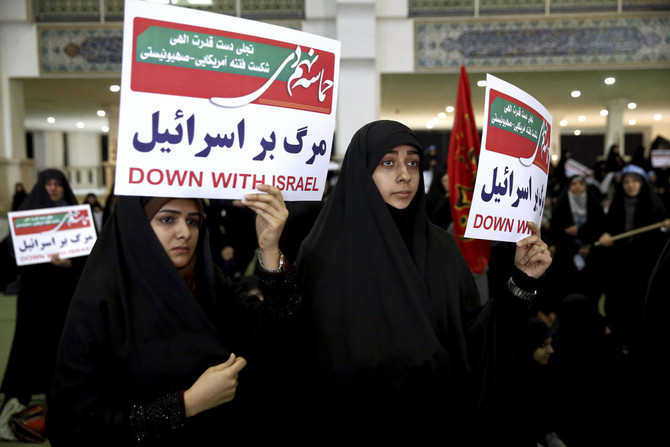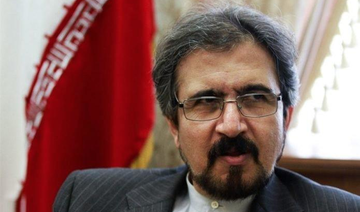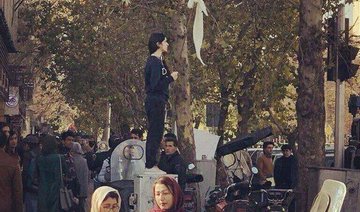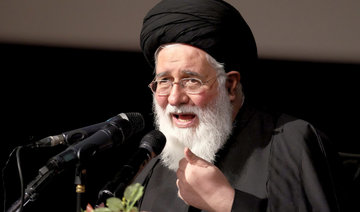TEHRAN: Iranian authorities warned against further “illegal gatherings” on Saturday, as protesters rallied for a third day of demonstrations driven by anger over economic problems.
A relatively small protest erupted at the University of Tehran but was vastly outnumbered by a pro-regime demonstration — part of a show of strength from the government that brought thousands to the streets.
Interior Minister Abdolrahman Rahmani Fazli warned against any further anti-government action, saying: “We urge all those who receive these calls to protest not to participate in these illegal gatherings as they will create problems for themselves and other citizens.”
Videos on social media had shown dozens of students around Tehran’s university chanting slogans against the regime — mirroring protests that began in second city Mashhad before spreading to several major towns.
But hundreds of conservative students later seized control of the entrance to the university, chanting “Death to the seditionists.”
The protests began on Thursday as an attack on high living costs but quickly turned against the Islamic regime as a whole.
State news channel IRINN said it had been banned from covering the protests that spread from Mashhad to towns and cities including Qom and Kermanshah.
Media coverage inside Iran focused almost exclusively on pro-regime rallies held earlier on Saturday to mark the defeat of the last major protest movement in 2009, which hard-liners call “the sedition.”
The timing was coincidental, since the rallies are held every year on this day, but offered a handy show of strength to the regime as huge crowds of black-clad supporters gathered across the country.
“The enemy wants once again to create a new plot and use social media and economic issues to foment a new sedition,” Ayatollah Mohsen Araki, a prominent cleric, told a crowd in Tehran, according to the conservative Fars news agency.
Video footage on social media showed hundreds marching through the holy city of Qom on Friday evening, with people chanting “Death to the dictator” and “Free political prisoners.”
There were even chants in favor of the monarchy toppled by the Islamic revolution of 1979, while others criticized the regime for supporting the Palestinians and other regional movements rather than focusing on problems at home.
Footage showed thousands gathered in the cities of Rasht, Hamedan, Kermanshah, Qazvin and elsewhere, with police responding with water cannons.
Officials were quick to blame outside forces for the unrest.
“Although people have a right to protest, protesters must know how they are being directed,” Massoumeh Ebtekar, vice president in charge of women’s affairs, wrote on Twitter.
She posted images from Twitter accounts based in the United States and Saudi Arabia, voicing support for the Mashhad protests.
Nonetheless, officials warned against dismissing the public anger seen in recent days.
“The country is facing serious challenges with unemployment, high prices, corruption, lack of water, social gap, unbalanced distribution of budget,” wrote Hesamoddin Ashena, cultural adviser to President Hassan Rouhani, on Twitter.
“People have the right for their voice to be heard.”
There has been particular anger at welfare cuts and fuel price increases in the latest budget announced earlier this month.
Since the 2009 protests were ruthlessly put down by the Revolutionary Guards, many middle-class Iranians have abandoned hope of pressing for change from the streets.
But low-level strikes and demonstrations have continued, often on a sector-by-sector basis as bus drivers or teachers or workers from specific factories protest against unpaid wages or poor conditions.
Some of this week’s protests were directed against financial scandals linked to unauthorized lending institutions which collapsed with the loss of hundreds of thousands of accounts.
Payam Parhiz, editor-in-chief of reformist media network Nazar that broke the news of the Mashhad protests, said they were more focused on the economy than those in 2009, which were sparked by allegations of election-rigging.
“Then, they were middle-class and their slogans went beyond economic matters to things like cultural liberties,” he told AFP.
“Today, the concerns are economic. There are people who have lost their life savings. They will protest until their problems are resolved.”
Since taking power in 2013, Rouhani has sought to clean up the banking sector and kickstart the economy, but many say progress has been too slow.
Aware that economic problems can quickly spiral into political chaos, officials from across the political spectrum have called for greater efforts to tackle poverty and the 12 percent unemployment rate.
“Solving people’s economic problems is the chief priority in the country,” tweeted Ebrahim Raisi, the hard-line cleric defeated by Rouhani in May’s presidential election.
Iran warns against ‘illegal gatherings’ on third day of protests
Iran warns against ‘illegal gatherings’ on third day of protests

Gaza aid still departing Cyprus by sea while landing pier fixed

NICOSIA: Humanitarian aid for Gaza is continuing to depart Cyprus by sea and will be held in floating storage off the coast of the enclave until a US-built military pier undergoes repairs, a Cypriot government official said on Thursday.
The US military announced earlier in the week that a purpose-built jetty it anchored off Gaza’s coast to receive aid by sea was being temporarily removed after a part of the structure broke off, two weeks after it started operating.
Cyprus Government Spokesperson Konstantinos Letymbiotis said offloading aid had slowed down, but the sea corridor had not ceased operating.
“The mechanism surrounding how the floating pier works allows for the possibility of floating storage off Gaza, with offloading to resume when conditions allow,” he said, blaming the problem on rough seas.
The pier was announced by US President Joe Biden in March and involved the military assembling the floating structure off the coast. Estimated to cost $320 million for the first 90 days and involve about 1,000 US service members, it went into operation two weeks ago.
A Pentagon spokesperson said a portion of the pier had separated and that the pier would be towed to Ashdod port in Israel for repairs. Letymbiotis said their information from the US was that the problem would be fixed in coming days and operation of the pier could ‘possibly’ resume by the middle of next week.
Eleven ship-shuttles of aid had left Cyprus since the operation started, with enough aid already disbursed to “provide food to tens of thousands of non-combatants for a month,” Letymbiotis said.
“The aim of offering humanitarian aid to 500,000 people a month is possible,” he said.
Rising violence strikes fear into West Bank school

“We tell the students ... to come to school together and not on their own, because we do not know when their (settlers) attack will be,” said Mazin Shehadeh, vice-principal for the high school located in a village south of the city of Nablus.
On the hill above the village sits the Israeli settlement of Yitzhar, from where Palestinians say settlers descend to attack them.
“Every day when we arrive, we inspect the area around the school for fear that there might be explosive devices,” said the educator, whose office floor was charred black by what he said was an arson attack.
Israel has occupied the West Bank since 1967 and now some 490,000 Israelis live across the Palestinian territory in settlements that are considered illegal under international law.
Palestinians have long faced harassment by settlers.
Recalling an attack on the school, one 15-year-old student said, “We were in class, and the settlers attacked us from the back of the school. They threw stones at the windows.”
“The (Israeli) soldiers were standing above, near the water tank, firing tear gas and stun grenades toward the school.”
Now the pupils fear an attack at any moment.
“At the slightest noise, at the slightest gunshot or at the slightest explosion near the town, we say to ourselves that the (Israeli) army or the settlers have attacked the school,” said Qais.
Since October 7, 519 Palestinians have been killed in the West Bank by Israeli soldiers or settlers, according to the health ministry in Ramallah.
More checkpoints and other Israeli military installations have been erected since the start of the war, complicating the journey to school.
“Sometimes the army harasses us, sends us tear gas bombs and sound bombs and prevents us from going to school,” said a 12-year-old student.
The school year, which ended on Wednesday, turned into “a nightmare” for Palestinian students, the United Nation’s children’s agency UNICEF has said.
Some 27.5 percent of elementary school students do not feel safe at school, according to a study by UNRWA, the UN agency for Palestinian refugees.
Between October 7 and May 7, 60 children were killed in the West Bank, 345 injured and 68 schools targeted by acts of vandalism, according to the Palestinian education ministry.
It said another 125 students have been detained by the Israeli military, who when asked by AFP about the arrests said they were part of their “counter-terrorism activities“
Last week, a 15-year-old boy was shot dead while evacuating from his school by bicycle during an Israeli military raid in the northern West Bank city of Jenin.
Even before the war, violence between communities in the West Bank near the school reached a record high.
In June 2023 two residents of Urif village, members of the armed group Hamas, killed four Israelis in an attack to the south.
In response, dozens of masked settlers could be seen in footage reviewed by AFP setting fire to a school and trees, and throwing stones at homes in the village.
In response to repeated attacks by settlers, school administrators in Urif said they had spent the equivalent of 62,500 euros on a tarpaulin to catch thrown stones and they have also installed barbed wire.
In the classrooms, thick purple curtains are drawn over barred windows, and staff run regular evacuation drills.
The violence and consequent fortifications have made students feel like they are trapped and “entering a prison,” said Shehadeh.
The school has had many of its “most hardworking and brilliant students” drop out, he added.
Others have left to help their parents, who have been without an income since Israel placed increased restrictions on Palestinians working in Israel.
Those pupils who remain only attend in-person classes three days a week and do the rest remotely due to the security concerns and the Palestinian Authority not paying teachers their full salaries.
However, not all students have the electronic devices or Internet connections needed to learn remotely, said Refat Sabbah, founder of the Teacher Creativity Center, a charity.
“In such a context, when students feel at risk at every moment, how can they learn? The psychological impact is huge on the students and the teachers,” he added.
Israel sent messages to Tehran to avoid Iranian response to embassy attack — agency

TEHRAN: Israel sent messages to Tehran via Egypt that it would “compromise” in Gaza to avert an Iranian response to an attack on Iran’s embassy in Syria, the Tasnim news agency reported.
The Iranian news agency’s report cited the head of Iran’s Revolutionary Guards Aerospace Force.
Iran launched explosive drones and fired missiles at Israel in April in its first direct attack on Israeli territory, a retaliatory strike for what it said was an Israeli strike on its Damascus consulate, in which seven officers of the Islamic Revolutionary Guard Corps were killed.
“Israel sent messages through Egypt’s foreign minister that it will compromise in the war in Gaza to avoid Iran’s retaliation,” Amirali Hajjizadeh said.
Ship attacked by Yemen’s Houthi rebels was full of grain bound for Iran, the group’s main benefactor
Ship attacked by Yemen’s Houthi rebels was full of grain bound for Iran, the group’s main benefactor

- The attack Tuesday on the Laax comes as the Houthis continue their attacks on shipping throughout the Red Sea corridor
DUBAI, United Arab Emirates: A Greek-owned, Marshall Islands-flagged bulk carrier that came under attack by Yemen’s Houthi militia earlier this week had a cargo of grain bound for Iran, the group’s main benefactor, authorities said Thursday.
The attack on the Laax comes as the Houthis continue their attacks on shipping throughout the Red Sea corridor, part of a campaign they say aims at pressuring Israel and the West over the war in Gaza. However, as shipping through that artery has dropped during the months of attacks, the militia have struck vessels associated with Iran, as well as Tehran’s economic lifelines of China and Russia.
Initially after the attack, the Laax had listed its destination as Fujairah in the United Arab Emirates. On Thursday, however, its listed destination instead appeared to be Bandar Khomeini, Iran.
A statement released by French naval forces based in the UAE that patrol the Middle East also identified the vessel’s grain shipment as being bound for Iran. It said that a team from Djibouti had inspected the damage caused by the attack, which it said involved both drones and missiles, and found no remaining dangerous explosives onboard the ship.
Images released by the French navy showed damage both at the waterline of the vessel, as well as on its deck.
Tuesday’s attack saw five missiles hit the Laax during the hourslong assault, the private security firm LSS-SAPU told The Associated Press. LSS-SAPU, which earlier helped evacuate mariners from the Houthi-attacked Rubymar that later sunk, said there had been no prior warning by radio from the Houthis.
LSS-SAPU had three armed security guards onboard the Laax at the time of the attack. Among the ship’s crew were 13 Filipinos and one Ukrainian, the Philippine Department of Migrant Workers said in a statement.
The Houthis in recent months have stepped up attacks on shipping in the Red Sea and the Gulf of Aden, demanding that Israel end the war in Gaza, which has killed more than 36,000 Palestinians there. The war began after Hamas-led militants attacked Israel on Oct. 7, killing about 1,200 people and taking around 250 hostage.
The Houthis have launched more than 50 attacks on shipping, killed three sailors, seized one vessel and sunk another since November, according to the US Maritime Administration.
On Wednesday, another US MQ-9 Reaper drone apparently crashed in Yemen, with the Houthis claiming they fired a surface-to-air missile at it. The US Air Force didn’t report any aircraft missing, leading to suspicion that the drone may have been piloted by the CIA. As many as three may have been lost this month alone.
Iran’s Khamenei hails US university students for Gaza support

- Universities in the US were rocked by pro-Palestinian demonstrations in April, triggering campus clashes with police and the arrest of dozens of people
TEHRAN: Iran’s Supreme Leader Ayatollah Ali Khamenei has praised university students in the United States for their protests over the rising death toll in the war in Gaza.
“You have now formed a branch of the Resistance Front,” said Khamenei, referring to Tehran-aligned armed groups across the Middle East arrayed against arch-foe Israel which is also known as the Axis of Resistance.
“As the page of history is turning, you are standing on the right side of it,” he said in a letter published on his official website on Thursday.
Universities in the United States were rocked by pro-Palestinian demonstrations in April, triggering campus clashes with police and the arrest of dozens of people.
The demonstrations began at Columbia University in New York and later spread across the country as well as to Europe and elsewhere.
Tehran has reiterated support for the Palestinian militant group Hamas since the outbreak of the war in the Gaza Strip.
The assault resulted in the deaths of 1,189 people, mostly civilians, according to an AFP tally based on Israeli official figures.
Israel’s retaliatory offensive has killed at least 36,171 people in Gaza, mostly civilians, according to the Hamas-run territory’s health ministry
Regional tensions have since soared, drawing in Iran-backed militant groups in Syria, Lebanon, Iraq and Yemen.
Tit-for-tat escalations led to Tehran launching hundreds of missiles and rockets directly at Israel last month.

















